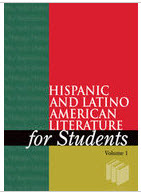| By Sarah Robertson |
An integral part of the U.S. literary canon, Hispanic and Latinx American literature includes works written by people of Latin American descent. A thriving tradition, Hispanic and Latinx American literature reflects the dynamic cultures and histories of the largest group outside of the historically dominant white culture of the United States. In its thematic diversity, Hispanic and Latinx American literature mirrors the rich tapestry of the American experience. Gale’s Hispanic and Latino American Literature for Students, Volume 1, showcases thirteen works by Hispanic and Latinx American authors, including Lin-Manuel Miranda, Elizabeth Acevedo, Juan Felipe Herrera, and Meg Medina.
Modern Hispanic and Latinx American literature has become more recognized since the U.S. Civil Rights movement of the 1950s and 1960s. Considered a pioneer in the field, Sabine Reyes Ulibarrí wrote about the history and traditions of New Mexico. His short story “My Wonder Horse” was published in 1964. Along with Rudolfo Anaya, Ulibarrí ushered in a wave of contemporary Hispanic and Latinx American literature, which proliferated concurrently with the Chicano and Nuyorican Movements of the 1960s and 1970s.
Latinx writers, including Julia Alvarez, Ana Lydia Vega, Gloria Anzaldúa, Cristina García, and Sandra Cisneros, flourished in the 1980s and 1990s. Notable works from prominent Latinx authors include Cisneros’s novel The House on Mango Street, Alvarez’s poem “Heroics,” and Vega’s short story “Cloud Cover Caribbean.” These authors examine the specific challenges that Hispanic and Latinx Americans face. The House on Mango Street, especially, provides insight into the inner lives and aspirations of Latinx American women.
The twenty-first century gave rise to works that explore coming of age through young-adult fiction. Examples include Matt de la Peña’s Mexican WhiteBoy, Elizabeth Acevedo’s The Poet X, Meg Medina’s Yaqui Delgado Wants to Kick Your Ass, and Carlos Murillo’s Augusta and Noble. Additionally, Hispanic and Latinx American authors have written within the fantasy genre, producing such works as Daniel José Older’s novel Shadowshaper.
Throughout its history, Hispanic and Latinx literature has grappled with issues of race, gender, and sexual orientation. Juan Felipe Herrera, for example, focuses on the experiences of migrants in his poem “Borderbus.” Tanya Saracho’s play Fade examines class, gender, ethnicity, and stereotyping in the context of the Latinx experience. Similarly, Gary Soto also touches on racial discrimination and socioeconomic status in his coming-of-age short story “Looking for Work.”
Overall, Hispanic and Latinx authors serve as critical voices in portraying the American way of life. A study of this literature reveals the unique experiences of Hispanic and Latinx Americans while also showcasing the complexities of American identity as a whole. Through a selection of key novels, drama, poetry, and short stories, Hispanic and Latino American Literature for Students, Volume 1, offers a sweeping survey of Hispanic and Latinx American literature to help you seamlessly incorporate it into the classroom.
Hispanic and Latino American Literature for Students, Volume 1, is available in print and eBook format through Gale eBooks.
Meet the Author
Sarah Robertson is a writer, editor, and longtime contributor to For Students.



Cost? Could I order?
20-768-7894
Catherine Korvin
Librarian
Academy of the Holy Angels Library
[email protected]
You can order online here: https://www.gale.com/ebooks/9780028666860/hispanic-and-latino-american-literature-for-students
Thank you!